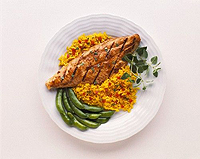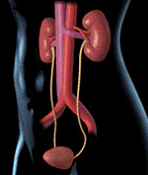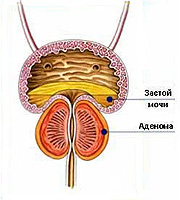Power recommendations for patients with chronic renal failure on software hemodialysis. In the treatment of hemodialysis, the power regimen for patients with chronic renal failure is in second place after the hemodialysis procedure itself.
Content
Food
The main principles in nutrition of patients on hemodialysis are:
- Liquid restriction.
- Restriction of consumption of cook salt.
- Restricting the consumption of products rich in potassium.
- Restriction of products rich in phosphorus.
- Sufficient use of protein.
- A sufficient amount of energy.
Liquid
With the beginning of treatment with dialysis, the amount of urine, as a rule, decreases. Do not drink more than daily diuresis plus 500 ml of liquid. An increase in body weight should not exceed 2 kg in the interdialysis period. Otherwise, the liquid is accumulated in the body and can lead to such serious complications as swelling of the lungs, brain swelling. Do not forget to consider that liquid, which is contained in vegetables, fruits, first dishes, sauces, gravy, dairy dishes and T. D. Quench thirst helps you a piece of lemon or a piece of ice.
Salt
Also to reduce thirst will also help the substantial restriction of the cook salt in your nutrition. Instead of salt to improve taste, dishes can add pepper, herbs, mustard, bay leaf, cinnamon, vanillin. To improve the taste quality of abolving dishes in the diet, sour-sweet sauces, sour cream, vegetable and fruit gravy, citric acid are introduced. To replace salt into boiled fish, you can add carnation, fragrant pepper; in stewed meat - basil; in potatoes onions, garlic; In any sharp dish - pepper, parsley. Mine, smoked salts and other products containing a lot of salt are excluded from the diet. Food prepare without salt and slightly spitting ready-made dishes (3/4 teaspoon without top, no more, salt on the day).
Potassium
 Own kidneys in patients with chronic renal failure almost do not distinguish potassium. Significant potassium accumulation in the interdialysis period can be very dangerous for your life! The only way to prevent hyperkalemia is a strict limitation in your diet of products rich in potassium.
Own kidneys in patients with chronic renal failure almost do not distinguish potassium. Significant potassium accumulation in the interdialysis period can be very dangerous for your life! The only way to prevent hyperkalemia is a strict limitation in your diet of products rich in potassium.
The following products contain a large number of potassium and should be avoided:
- Dairy products (Circulated milk, condensed milk without sugar);
- Vegetables (bean products, mushrooms, spinach, potatoes in uniform, fried potatoes, chips);
- Fruits (apricots, bananas, dried fruits, nuts, rhubarb);
- Bread products (bran, fruit and chocolate cakes, chocolate cookies, crispy loaf, oatmeal);
- Drinks (coffee, beer, wine, cocoa, drinks from cocoa);
- Mixed (salt substitutes, chocolate, iris, fruit chewing gum, chocolate oil, tomato puree, vegetable soups).
Comments: The main sources of potassium are vegetables and fruits. Therefore, it is necessary to limit the number of fresh fruits and the amount of salads. To reduce potassium content in vegetables, they should be cleaned, finely cut and soaked for 6 – 10 hours of vegetables should be boil in a large amount of water, decay pour. It is not recommended to cook vegetables for a couple, use the pressure cookers, a microwave, fry them. Canned fruits contain less potassium than fresh, but syrup should be poured. Rice and pasta contain less potassium than potatoes, so their use is preferable.
Phosphorus
Increased in the blood of phosphorus indicators for a certain time can lead to a violation of calcium exchange, diseases of bones and parathyroid glands.
One of the ways to prevent these complications is the limitation of high phosphorus products:
- Dairy products (cheeses, raw materials, condensed milk with sugar and sugar, milk, yogurt and t. D.);
- Sub-products (liver, kidneys, heart and t. D.);
- Fish (smoked fish, mackerel, sardines, trout, caviar humpback caviar knakes, sturgeon caviar);
- Yolk eggs;
- Mushrooms, nuts, seeds;
- Drinks (dairy and chocolate drinks);
- Bread products (bran, wheat pellets. Chocolate Cookies. Chocolate cake).
Doctor, if necessary, assign you a medicine that will help reduce the phosphorus content in the blood (calcium preparations). It is important to remember that it should be taken before the meal or during food. Otherwise it will not give any effect. To limit the intake of phosphorus, it should often look into the supply tables of nutrients and exclude or limit the products with a high phosphorus content or high phosphoric protein coefficient (more than 20). The phosphoric coefficient is the ratio of the amount of phosphorus in the product in mg to the content of protein in g.
Proteins
 The diet of patients on hemodialysis must be high. Failure to comply with this rule can lead to a decrease in muscle mass, depletion, dystrophic changes. You must consume 1 - 1.2 g of protein per kg of recommended body weight per day. It is important to note that preference is given to proteins, full-fledged amino acid composition, mostly, this is an animal protein (non-fat varieties of beef, chicken, turkey, rabbit, language in boiled form).
The diet of patients on hemodialysis must be high. Failure to comply with this rule can lead to a decrease in muscle mass, depletion, dystrophic changes. You must consume 1 - 1.2 g of protein per kg of recommended body weight per day. It is important to note that preference is given to proteins, full-fledged amino acid composition, mostly, this is an animal protein (non-fat varieties of beef, chicken, turkey, rabbit, language in boiled form).
However, many full-fledged protein dishes contain a large amount of phosphorus, so the use of them must be controlled (fish, dairy products, eggs). So the varieties of fish are allowed in which phosphorus content is low: macrolarus, pike, cod, seven. Milk need to be limited to the 1st cup per day, resolved sour cream up to 150 g per day. Eggs – 4 pieces per week in the form of a protein omelet, schiek and for the preparation of other dishes. Meat and fish are given in the boiled form or followed by roasting, due to this, the number of extractive substances is reduced.
Fat
The amount of fat in the diet should be optimal. Creamy (20g per day) and vegetable oils (sunflower, olive, cotton and t.NS.). These oils are not only good for taste, but also contribute to the normalization of cholesterol exchange. Tug carrier fats are excluded.
Carbohydrates
The amount of carbohydrates in the diet of patients on hemodialysis should be optimal. Patients who have a shortage of body weight are allowed to increase the calorie content of its diet due to carbohydrates (sweet dishes – sugar, honey, jam, kisyl, mousses and t.D.). Dishes and side dishes and pasta are limited. Used in the form of a pill with fruit, casserole, in the form of a side dish. Patients having diabetes should monitor the consumption of carbohydrates under the cover of sugar preparations (insulin) under the supervision of the doctor.
Calorie
The need for energy in patients receiving treatment with dialysis is high. It is usually 35 kcal per kg of patient weight and depends on physical activity. The higher the physical activity, the higher the need for energy. A significant part of the energy needs should be covered by fats and carbohydrates. To increase the energy value of food, it is allowed to fry cooked in boiled products. To cause an appetite in a patient, not only spicy greens, but also a limited number of cranberry, lemon, orange, currant, brushing drinks, do not take place in small doses dry wine, Kahors, brandy. Patients having an overweight body and elevated blood lipids should be reduced by the use of fats: limit the number of animal fat, not fry food; Avoid confectionery, consulate products with low fat and sugar content.
So, dear patients! Our nutrition recommendations are aimed at improving the quality of your life! Performing them, you can avoid possible complications.









